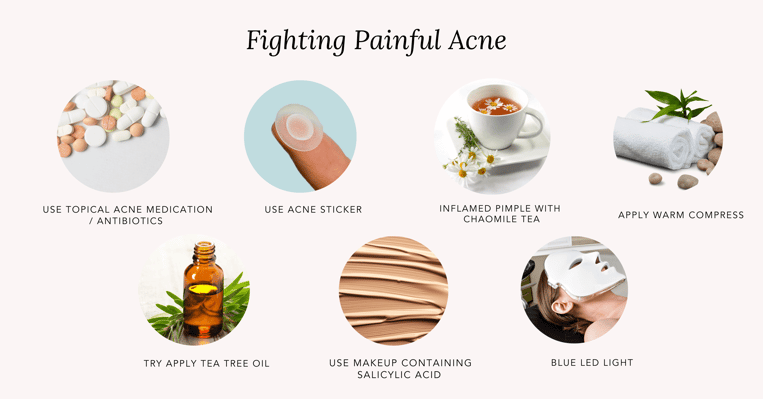Acne. A word that brings back painful memories of confidence-killing breakouts that plagued our teenage years – or not, if you were part of the small minority of people blessed with flawless skin. A common misconception is that acne only affects teenagers, however adults are also prone to their fair share of acne trauma in their 20’s, 30’s, 40’s and even up to their 50’s.
Acne comes in myriad forms, from milder and less irritating blackheads and whiteheads to the most severe type of acne – pimples that develop deep in the skin and cause painful and swollen bumps. Acne is caused by a variety of factors, including stress, hormonal imbalance, pollution, humidity, and infrequent face washing or exfoliation – all of which can affect you at any point in your life.
How is acne formed?
All types of acne are caused by a combination of sebum (an oily substance secreted by your sebaceous glands to lubricate skin and hair), dead skin, bacteria, and dirt that becomes trapped in your pores. If infection occurs, acne can turn into painful pimples – inflamed cysts that swell near minor nerve endings, causing more pain the larger it becomes.
Acne typically appears on the areas of the skin with the most sebaceous glands including face, forehead, chest, and upper back, and can take weeks to months to go away on its own.
What are home remedies for treating pimples?
First, on what you shouldn’t do: whatever you do, don’t pop it! Popping pimples carries the risk of scarring, discoloration, and further irritation and infection and it just isn’t worth it.
Here’s what you should do instead to treat persistent acne breakouts -
-
Use topical acne treatments
Such as creams and cleansers with acne-fighting ingredients. Effective ingredients to look out for include benzoyl peroxide and salicylic acid, the former of which works as an antiseptic to reduce the number of bacteria on the skin surface, while the latter removes dead skin cells and excess oil. Azelaic acid has antibacterial properties that can help to soothe inflammation and kill p. Acnes bacteria, while topical retinoids (typically prescribed) can enhance cell turnover, keep pores clear, and prevent sebum build-up.
-
Use medicated acne patches overnight
It can keep bacteria out, and healing ingredients in. Most are hydrocolloid bandages that absorb fluid from the pimple, flattening out the skin and ridding it of redness.
-
Go back to basics, and ice the inflamed pimple
Another tip is to DIY a cold compress with cotton and chamomile tea, which has natural antiseptic and anti-inflammatory properties, to soothe surface-level pimples.

-
Apply a warm compress to help release pus more quickly
Press a warm and damp towel directly against the whitehead for 10 minutes, 3 times a day.
-
Use makeup that contains salicylic acid
It can get tempting to cover up your pimples with all manners of concealers and foundations, but if you’re going to do that, you might as well do it with makeup that contains pimple-fighting ingredients. Invest in formulas containing salicylic acid to help keep your pores clear.
-
Blue LED light
One of the most popular modern technologies used for treating and preventing pimple breakouts, blue LED light is proven to kill acne-causing bacteria and balancing sebaceous gland activity to prevent excessive oil production. This method is chemical-free, painless, and easy to perform at home.
How can you prevent future breakouts of pimples and cystic acne?
-
Use non-comedogenic (non-pore clogging) cleansers, moisturizers, and sunscreens
Aside from maintaining good personal hygiene – which includes washing your face twice daily – remember to pick your facial products wisely. While water-based cleansers and moisturizers are popular picks for acne-prone skin, don’t be so quick to dismiss oil-based products. For example, mineral oil is proven to be a great emollient that doesn’t leave pore-clogging residue on the skin. People with dry skin that produces excess oil to overcompensate can benefit greatly from non-comedogenic facial oils that can restore the skin’s natural oil and water levels.
-
Exfoliate regularly to prevent the build-up of dead skin, which can trap oils and cause breakouts
There are a few ways to go about this, starting from a gentle mechanical face scrub to the use of more deep-acting peels such as Alpha Hydroxy Acid (AHA) or Beta Hydroxy Acid (BHA). BHA is typically more effective for oily and acne-prone skin to unclog pores (e.g. salicylic acid), while AHA is best for dry skin and resolving surface-level skin concerns like acne scars.
-
Maintain a clean diet
Load up on pineapple, papaya, and yogurt – all of which are rich in digestive enzymes and good bacteria. Drink lots of water daily, around 6-8 glasses, to maintain a healthy balance of water in your body to keep skin elastic and to eliminate dryness.
And finally, seek professional help if your pimples itch, burn, ooze, look more like blisters or crust over. If you see large bumps or cysts under the armpits or around the groin, or if pimples change in colour, shape or size in a short period of time, then it’s time to visit your dermatologist’s office.
Ultimately, acne pimples aren’t harmful nor life-threatening (although severe cases may feel like doomsday) and can be resolved with one or a few effective home treatments.
.png?width=180&height=80&name=imgpsh_fullsize_anim%20(1).png)

